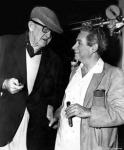I'm interested in some intelligent discussion regarding cone driver "break-in". My current reasoning tells me that a cone driver's suspension has the proper (intended) compliance upon assembly, and that this same compliance should continue for the life of the driver. However, many claim that cone drivers must be "broken in" by continuous long excursions before they will perform as designed. I contend that if a driver's compliance can be altered substantially in a few hours use, that such change would continue with further use, and soon render the driver useless. Do any manufacturers recommend break-in?



 Reply With Quote
Reply With Quote





 ]
]



